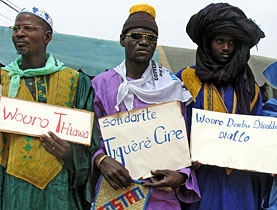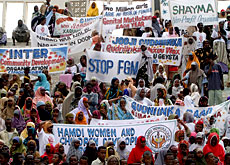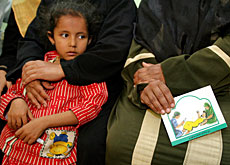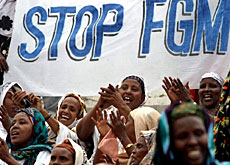Campaigners call for end to female circumcision

Every year around three million girls, mostly under 15, undergo the traumatic practice of female genital mutilation – almost one every ten seconds.
To mark the International Day of Zero Tolerance to Female Genital Mutilation, around 150 people took part in a conference in Geneva on Wednesday looking at ways of putting an end to the practice.
Some 130 million women are affected by genital mutilation, mostly in Africa, the Middle East and Indonesia, but also in immigrant communities throughout the world, including Switzerland.
Campaigners say that while progress is slowly being made, the phenomenon occurs on a much larger scale than previously thought and it continues to be one of the most persistent, pervasive and silently endured human rights violations.
“We have come a very long way since the 1980s when it was difficult to talk about this subject, which is a deeply rooted norm accepted by society,” said Berhane Ras-Work, from the Inter-African Committee on Traditional Practices. “But traditional and cultural norms are not static.”
Female circumcision has been widely condemned for violating girls’ and women’s human rights, so why is it still practised, asked Madeline Rees, from the Office of the United Nations High Commissioner for Human Rights.
Researchers seeking to understand how and why the practice persists are confronted with what appears to be a paradox: in many cases, parents and other family members are perpetuating a tradition that they know can bring harm, both physical and psychological, to their daughters. The answer likes in social dynamics in communities.
“In countries where it is performed, if you don’t conform to tradition you are alienated from society. It’s impossible to get married, and in countries where women are dependent on men, how can they resist?”
Participants acknowledged that national governments must create a protective environment for women and children and encourage people to give up the practice through social and economic measures and appropriate legislation. Advocacy and awareness-raising activities, involving the media and civil society are also crucial.
“The responsibility for upholding human rights lies with the states,” said Rees. “We need to make sure that when we raise awareness, states must support the fight and report so that we can judge, benchmark and end this torture.”
“Politics is a difficult subject in Africa,” said Ras-Work. “When in Geneva politicians talk the language of human rights, then back home it’s a different language. It’s up to the non-governmental organisations to open the door.”
Swiss cases
It is estimated that around 7,000 girls or women living in Switzerland are circumcised or are at risk of being so, 1,200 of whom are based in the Geneva region.
Unicef Switzerland has been campaigning against the extremely painful practice for years, focusing on protection and education.
Most mutilated girls in Switzerland come from Somalia, Ethiopia and Eritrea and the practice is carried out in secrecy and in unhygienic conditions. Girls are either taken abroad or those who carry out the cutting travel to Switzerland and mutilate them before leaving the country.
According to Alexandra Rossetti from Unicef Switzerland, there is great need for guidance for Swiss nursing staff and doctors, and the legal situation needs to be clarified.
Under Swiss law, only the two strong forms of female genital mutilation – infibulations and excision – are punishable as grievous bodily harm.
The House of Representatives and the Senate have both approved a parliamentary initiative demanding a full ban on female circumcision. However, it is yet to be made law and this could take one or two years.
The first case of female genital cutting that took place in Switzerland is due to come before the courts in March or April 2008.
“Of course repression is one way but it’s not enough. We need more information among the whole population, but especially among the concerned population,” said Rossetti.
Unicef Switzerland recently launched its fourth integrated awareness campaign and plans to hold an international female mutilation conference on February 21-22 to share experiences between European and African countries.
swisinfo, Simon Bradley in Geneva
Most frequent incidence of female genital mutilation (Unicef figures)
Guinea: 99% (legally banned since 2002)
Egypt: 97% (legally banned since 1996)
Mali: 92% (punishable as bodily harm)
Somalia: around 90%
Sudan 90%
Genital cutting is a deeply rooted cultural tradition in more than 28 African countries and in several countries in the Middle East and Asia.
The World Health Organization estimates 100-140 million girls and women have undergone female genital mutilation and Unicef claims that up to a further three million girls, mostly aged between four and 12, have their genitals cut every year.
Female circumcision can have severe short- and long-term consequences on women’s physical, mental and reproductive health – and their babies. Immediate complications include severe pain, difficulty to urinate, infections and in extreme cases, death due to uncontrolled bleeding. Over time, victims suffer from painful scar tissue, pains during menstruation and infertility. Women who have been circumcised also run greater risks during childbirth.
As a result of immigration from Africa, genital cutting has also become an issue in Europe. It has been banned in Austria, Belgium, France, Denmark, Britain, Norway, Spain and Sweden.
In canton Geneva, the International Organization for Migration (IOM), in collaboration with the cantonal department for the promotion of equality between men and women, set up a prevention programme in 2005 for people from Ethiopia, Eritrea, Somalia and Sudan focusing on information for health professionals and migrant communities.

In compliance with the JTI standards
More: SWI swissinfo.ch certified by the Journalism Trust Initiative




You can find an overview of ongoing debates with our journalists here. Please join us!
If you want to start a conversation about a topic raised in this article or want to report factual errors, email us at english@swissinfo.ch.